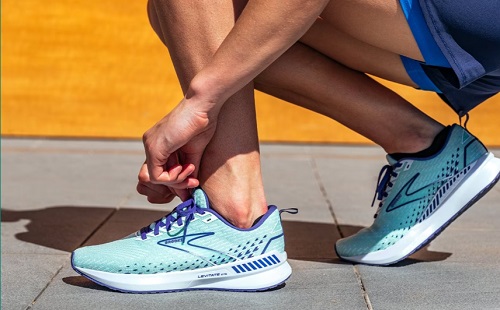Breaking in new running shoes is crucial for any runner. Wearing brand-new shoes without proper break-in can lead to blisters, discomfort, and even injuries. The process of breaking in new running shoes is simple but essential for ensuring that your feet adapt to the new pair, offering you the best performance and comfort during your runs. In this guide, you’ll learn how to break in new running shoes safely, ensuring that your feet and shoes are ready for the miles ahead.

How Long Does It Take to Break in New Running Shoes?
The time it takes to break in new running shoes can vary depending on several factors, such as the type of shoe, the material, and your running habits. Typically, it takes about 2-3 weeks to fully break in a new pair. During this period, your shoes will gradually conform to the shape of your feet, becoming more comfortable with each run. However, it’s important to listen to your body. If you experience persistent discomfort, it might be a sign that the shoes aren’t the right fit for you. Understanding how long it takes to break in new running shoes is key to avoiding unnecessary pain and ensuring a smooth transition to your new footwear.
Why Is It Important to Break in New Running Shoes?
Avoiding Blisters and Discomfort
Breaking in new running shoes helps prevent blisters and discomfort by allowing your feet to adjust gradually to the new fit. New shoes can have stiff materials that rub against your skin, causing friction and leading to painful blisters. By wearing your shoes for shorter periods initially and gradually increasing your running time, you can minimize the risk of blisters, ensuring a more comfortable running experience.
Enhancing Shoe Longevity
Properly breaking in your running shoes can extend their lifespan. When shoes are broken in gradually, the materials soften and conform to your feet, reducing stress on the shoe’s structure. This not only makes the shoes more comfortable but also helps maintain their integrity over time. A well-broken-in shoe will last longer and provide consistent performance, making your investment worthwhile.
Preventing Running Injuries
One of the most important reasons to break in new running shoes is to prevent injuries. New shoes that aren’t broken in properly can cause issues like shin splints, plantar fasciitis, and joint pain. By allowing your feet and muscles to adapt to the new shoes gradually, you reduce the risk of these injuries, keeping you on track with your training goals.

How to Break in New Running Shoes Effectively
Gradually Increase Your Running Distance
Start by wearing your new running shoes for shorter runs, gradually increasing the distance over time. Begin with 20-30 minute runs, and as your feet adjust, you can increase the duration and intensity. This method allows your shoes to mold to your feet without causing excessive strain or discomfort. Gradual progression is key when learning how to break in new running shoes effectively, ensuring that both your feet and shoes are ready for longer distances.
Wear Your Shoes for Short Walks First
Before hitting the pavement for a run, wear your new shoes around the house or during short walks. This will help soften the materials and allow your feet to get accustomed to the new fit. Walking in your new running shoes before running in them is a simple yet effective way to break them in, reducing the likelihood of blisters and discomfort during your runs.
Monitor Foot Pain and Discomfort
Pay close attention to any pain or discomfort you experience while breaking in your new running shoes. If you notice any persistent issues, such as hot spots or unusual pain, take a break from wearing the shoes and allow your feet to recover. It’s essential to listen to your body during this process to avoid turning minor discomfort into a more serious injury. Monitoring foot pain and discomfort is a critical step in ensuring that your shoes are a good fit for your running needs.
What to Do If Your New Running Shoes Hurt?
If your new running shoes cause pain or discomfort despite following the break-in process, it may be a sign that they are not the right fit for you. Consider trying different lacing techniques to alleviate pressure points or using insoles for additional support. If the pain persists, you may need to return the shoes and opt for a different pair. Knowing what to do if your new running shoes hurt is essential for maintaining your comfort and preventing long-term injuries.
Conclusion
Breaking in new running shoes is a necessary process that ensures your comfort, enhances shoe longevity, and helps prevent injuries. By understanding how to break in new running shoes safely and effectively, you can make the most of your new pair, enjoying better performance and comfort during your runs. Remember to be patient and listen to your body throughout the process, as proper break-in is key to a successful running experience.
FAQ
1. How often should I replace my running shoes?
Running shoes should typically be replaced every 300-500 miles, depending on the type of shoe, your running style, and the surfaces you run on. Regularly inspecting your shoes for signs of wear can help you determine when it’s time for a new pair.
2. Can I break into running shoes without running?
Yes, you can break in running shoes without running by wearing them for short walks or during other low-impact activities. This allows the shoes to soften and conform to your feet without the added stress of running.
3. How do I know if my running shoes are the wrong size?
If your running shoes cause persistent discomfort, blisters, or pain, they may be the wrong size. It’s important to have your feet measured and to try on shoes at the end of the day when your feet are at their largest to ensure the best fit.
